Legend Position Options for Multi-Page Outputs for Version 7.0
Contents
About Legend Positioning
In addition to showing and hiding the Legend on all pages or some pages, OnePager provides the controls in the Chart Properties form and the Template Properties form to make Legend position decisions for the entire document and chart. These controls allow you to position the Legend either inside the graph area or on the document area at various points.
The graph area is the rectangle that contains all the task bars and milestone symbols, excluding text columns and swimlane labels, time axis annotations, margins, headers, footers, and the chart title.
The document area is the entirety of the OnePager document with a specified page width and height and contains the graph area.
To better explain the Legend positioning options, the illustration below shows how subdivisions of a page in a OnePager chart is defined:
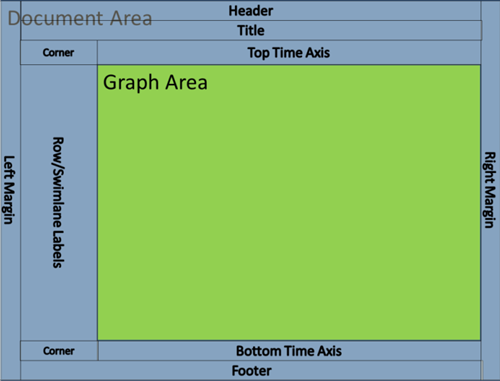
The concepts for Legend docking applies to both single and multi-page charts. The concepts for Legend anchoring applies only to multi-page charts.
For more information on multi-page output, please see the article at: Creating Multi-Page Charts (Portal)
This article explains these two concepts and the controls for using them to place the Legend where desired.
Additional Legend Positioning Considerations
When creating multi-page charts, some additional thought must be given to Legend positioning.
There are four (4) options available in OnePager for setting the initial position of the Legend for single and multi-page charts:
- 1) Docked to page – Place the Legend at one of eight (8) predetermined positions along the edges of the page.
- 2) Docked to graph – Place the Legend at one of (8) predetermined positions along the edges of the graph area.
- 3) Free Floating – Without using any of the predetermined positions, this option places the Legend at an arbitrary location outside the graph area.
- 4) Anchored to page - Place the Legend at a fixed distance reference point from one of the eight (8) predetermined positions and maintains this distance on all pages where the Legend is displayed.
Visualizing Docking and Anchoring
To assist you with visualizing the definitions of docking and anchoring in this context, here is an analogy supported by an illustration. Suppose that we think of the sixteen (16) predetermined positions as berths in a harbor with two piers for berthing boats, one on the perimeter of the harbor and one pier on an island.
The eight berths along the shore (i.e., perimeter of the harbor) correspond to the predetermined positions associated with the document area and the eight (8) berths around the island correspond to the predetermined positions associated with the graph area. The diagram below is a picture of the harbor with the island with their available berths:
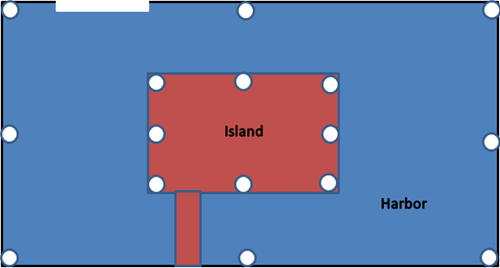
Now, thinking of the Legend as the boat and each of the four (4) berthing options as the OnePager Legend positioning options, we can carry the analogy a bit further:
- 1) Docked to page – Think of this as the boat in a harbor and assigned to one of eight (8) berths along the harbor’s perimeter where the boat is fixed tightly to the berth.
- 2) Docked to graph – In a similar way, think of this as the boat assigned to one of eight (8) berths around the island and fixed to the berth without any slack in the tie up lines.
- 3) Free floating – For this case, think of the boat in the harbor but not secured tightly to any of the sixteen available berthing positions. This might be similar to a boat tied up to a buoy in the harbor.
- 4) Anchored to page – Here, think of our boat in the harbor but not tied up tightly to any one of the eight (8) harbor perimeter berths. Rather, the boat is secured to the berth by a rope that keeps it a fixed distance from a berth itself along the harbor’s perimeter.
Using this analogy, what does the OnePager chart look like as a single page document and as a multi-page document using the four (4) options described above?
- 1) To make it clear, we use a sample chart where we’ve created the document with large margins to help illustrate the concept.
- 2) The graph area is the OnePager chart component that contains all the tasks and milestones.
- 3) The document area is the graph area PLUS text columns, swimlane labels, time axis, title, headers, footers, and margins.
Dock to Page
The example Print Preview below places the Legend in the upper right corner of the document area in the single page chart where the right margin is larger for illustrative purposes:
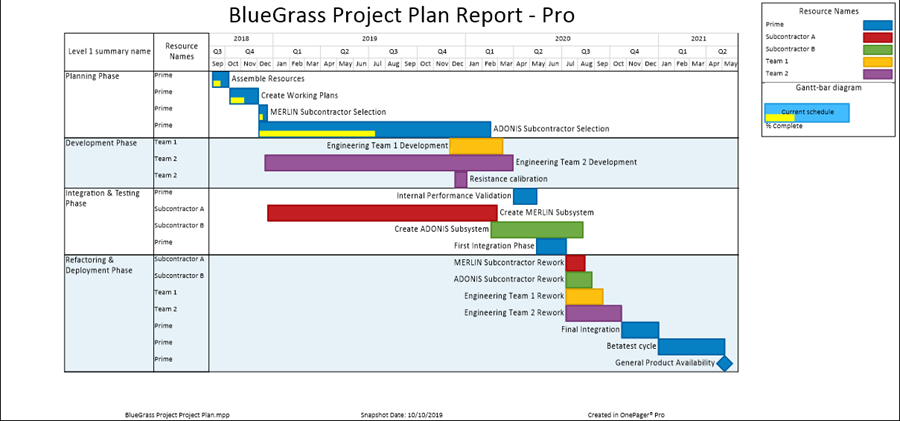
In the above illustration, the Legend is docked to the upper right corner of the page meaning it is outside the graph area but contained within the document area. If we change this chart to a 2 by 2 document of four pages with the same margin settings, the Print Preview looks like this:
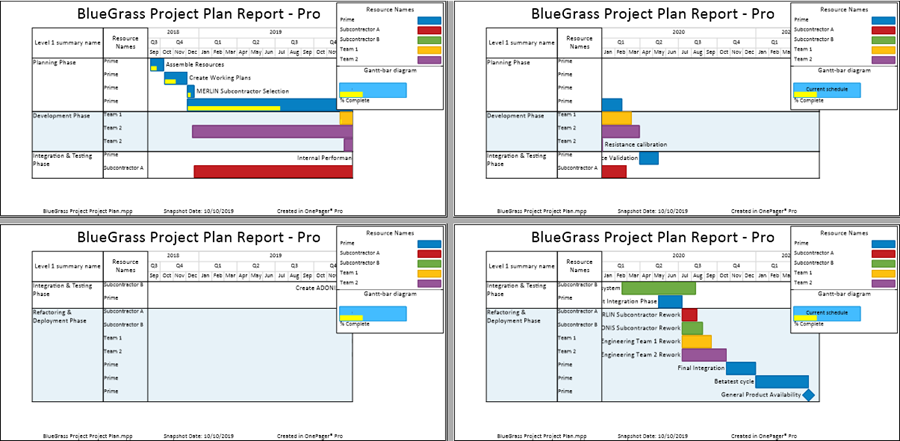
In the Print Preview above of the four page document with the Docked to page option, the Legend remains in the upper right corner of the page on all four pages. The legend itself does not change dimensions.
Dock to Graph
The example for Docked to graph shown in the Print Preview below places the Legend in the upper right corner of the graph area in the single page chart:
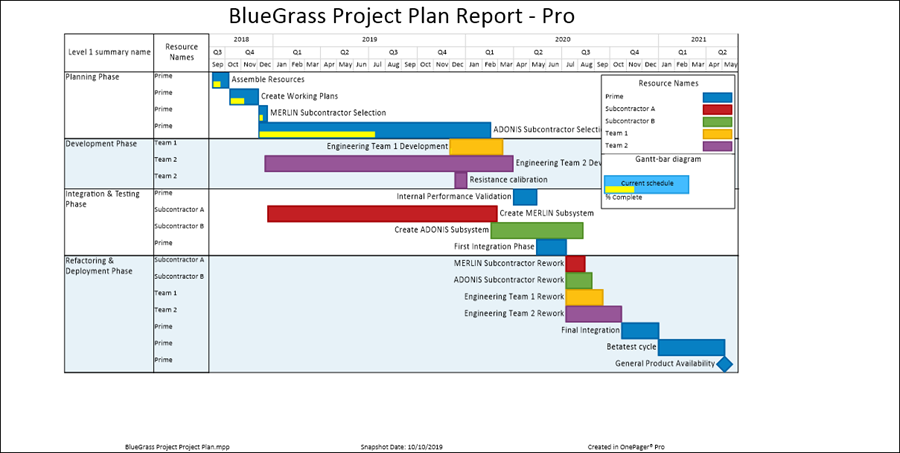
As shown above, the Legend is clearly docked in the upper right hand corner in the graph area. For the multi-page Print Preview we changes the chart from a 1 by 1 to a 2 by 2 configuration and leave the Legend controls unchanged. When we do this the Docked to graph presents a set of pages that looks as follows:
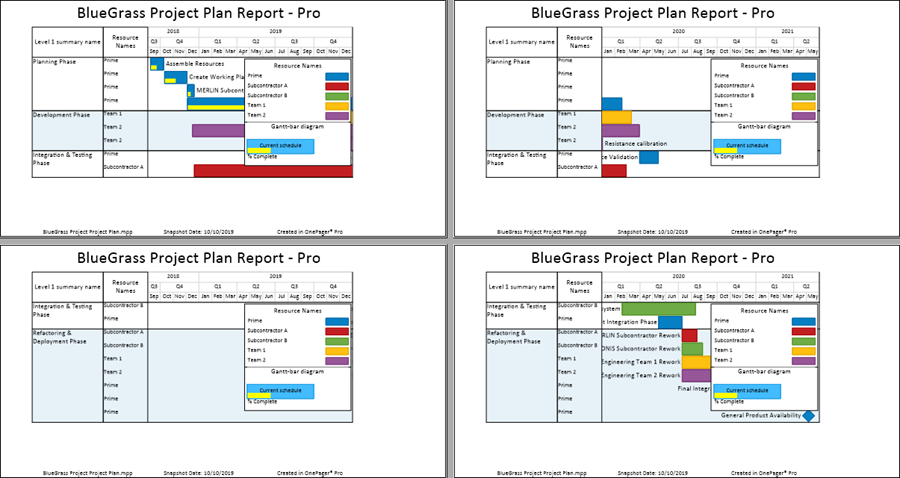
The Legend is clearly placed inside the graph area on all pages. Also, since this example is for illustrative purposes, the Legend is oversize but nevertheless the same size as the Legend in the single page example previously.
Free-Floating
The Free-floating option provide ultimate flexibility but can cause inconsistent results with multi-page outputs. As mentioned above, this option is without any docking or anchoring at all and depends on where you place the Legend manually.
As an example in a single page document, suppose we are using the Free-floating option and place the Legend away from all docking points on the first page as shown below:
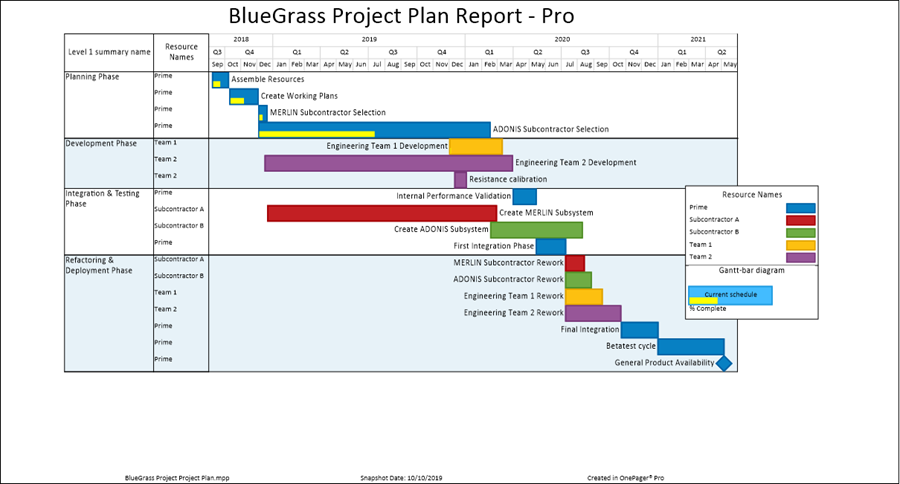
In the chart above, we’ve manually placed the Legend where you see it - not totally outside the graph area and not totally inside the graph area. When we change the pagination from 1 by 1 to 2 by 2 we get the following result:
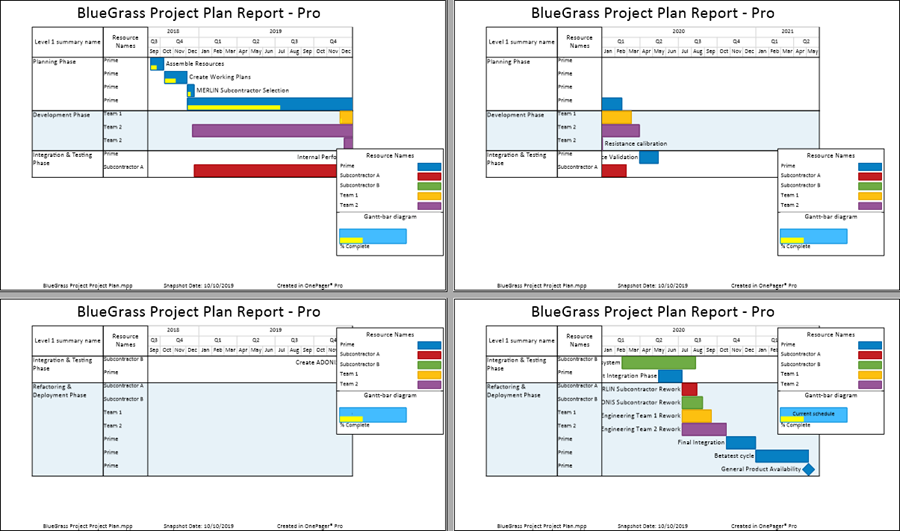
Notice how the Legend moves around from page to page. It doesn’t remain where we intended except on page 2 above. This is because OnePager is trying to keep the Legend in a position relative to the two page breaks that define each page, while also keeping the Legend on the page. Considering page 1 above, the Legend’s center is on the page break that defines the right edge of page 1.
But OnePager doesn’t want to put the Legend off of page 1, so it puts the Legend as shown in page 1 above.
Page 4 shows a similar hugging of the top graph area boundary and page 3 shows hugging the top of the graph area and right edges of the page. Since, in this example, we wanted to place the Legend in a location centered between the right edge of the chart and the right edge of the document area, but the output with the Free-floating option does not preserve this intent. To accomplish this we need to turn on the Anchored to page option presented next.
Anchor to Page
The Anchored to page option, when compared to the Free-floating option discussed above, provides better results in the multi-page presentations because the anchoring forces the Legend's center to maintain the same displacement from a reference location on every page. Using the information from the eight (8) compass points, allows OnePager to replace the Legend's right edge hugging by a more sensible spacing from each page’s edges.
We can also achieve consistent positioning by using the Docked to page option. But if you want to move the Legend slightly away from these eight (8) predefined positions and still maintain page-to-page consistency, using the Anchored to page option is the solution. Anchoring is a much more flexible way to position the Legend at a consistent location on the page.
Example
To show an example, let’s create a single page chart with the margins expanded and the Legend positioning option set to the Anchored to page option. The resulting chart look like this:
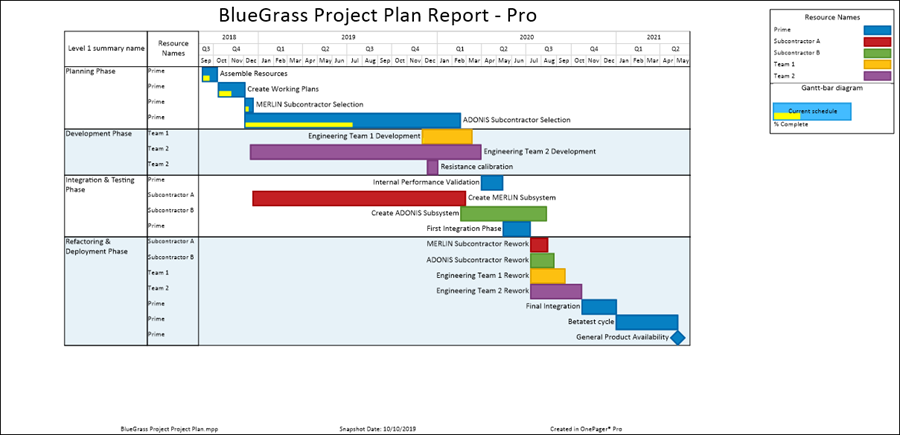
If we now create a 2 by 2 document while using this Legend position and positioning option, we get the result shown below where the Legend is anchored to the upper-right corner of the page:
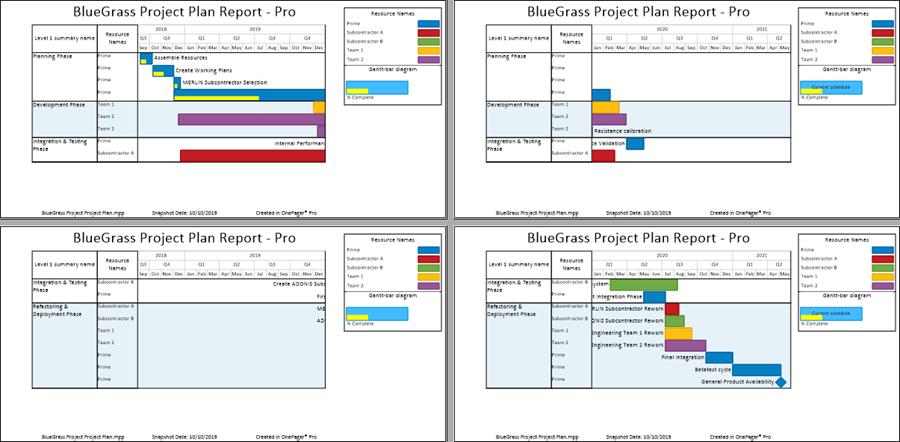
Above we see that all four pages of the document have the Legend positioned consistently in the same relative position. Subsequent re-positioning of the Legend in the Normal or Page Break view modes correspondingly re-positions the Legend on each of the multiple pages. Finally, it is important to note that anchoring achieves page-to-page consistency for non-in-the-margin locations too.
However, being in a page consistent location on each page is no guarantee that the Legend does not obscure some task shapes and milestone shapes or text labels on some of the pages. In practical terms, in-the-margin locations for the Legend are the safe bet for consistent Legend positioning in multi-page outputs.
Related Links
Creating Multi-Page Charts (Portal)
Manual Editing Task/Milestone Shapes and Text Labels (Portal)
Editing with the Chart Properties form (Portal)
Legend Tab for OnePager Express
(15.2.1-70)